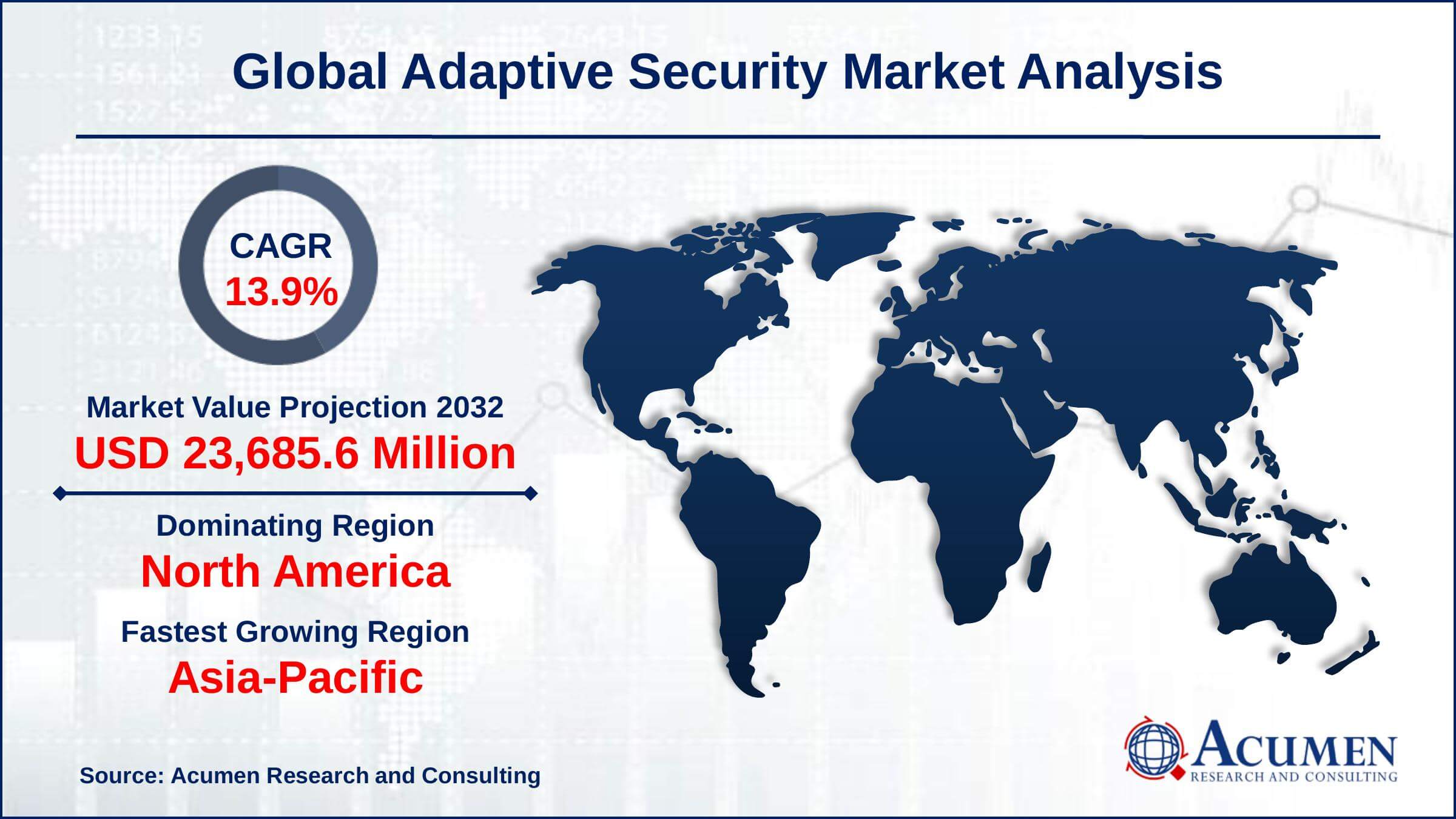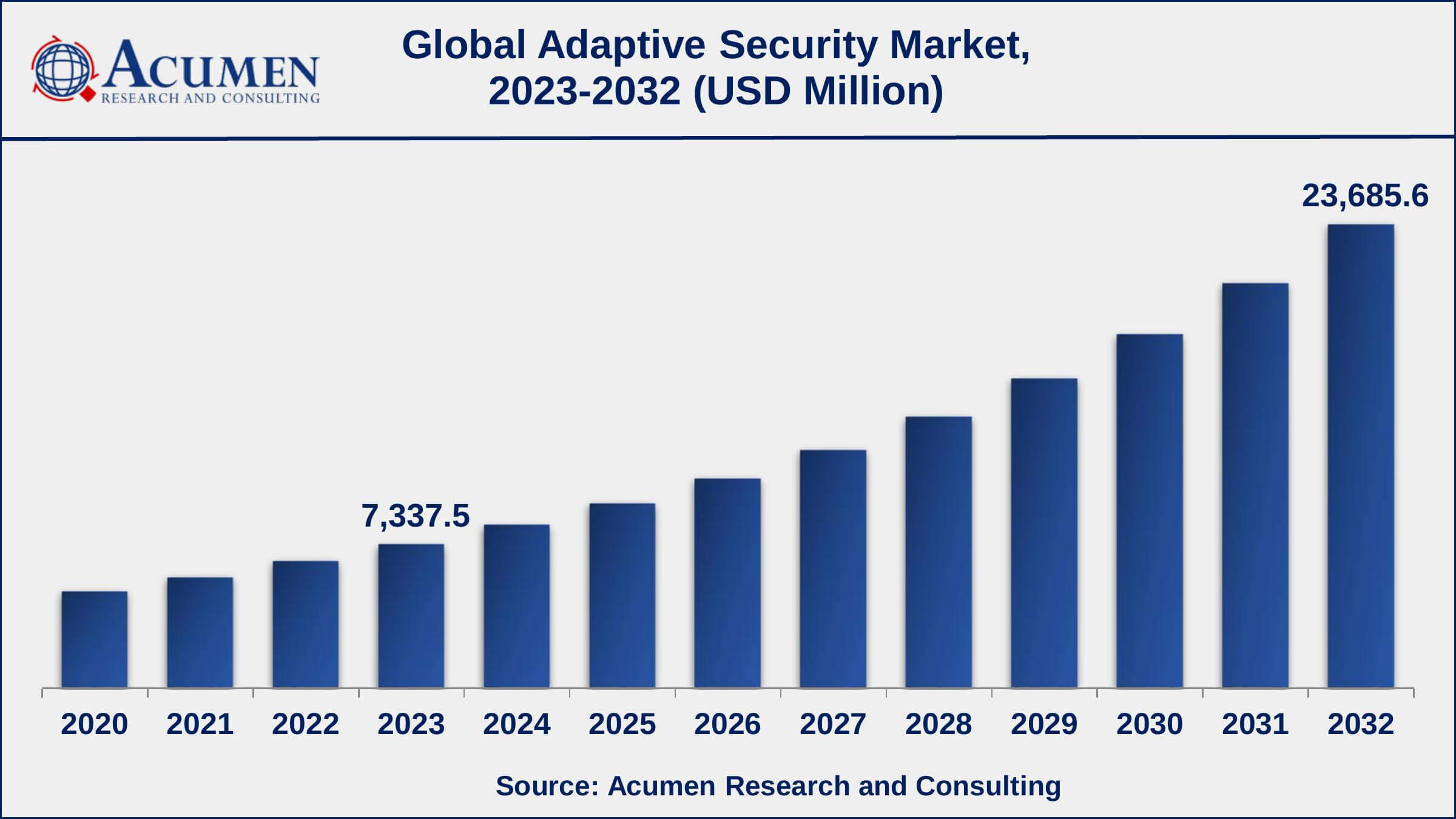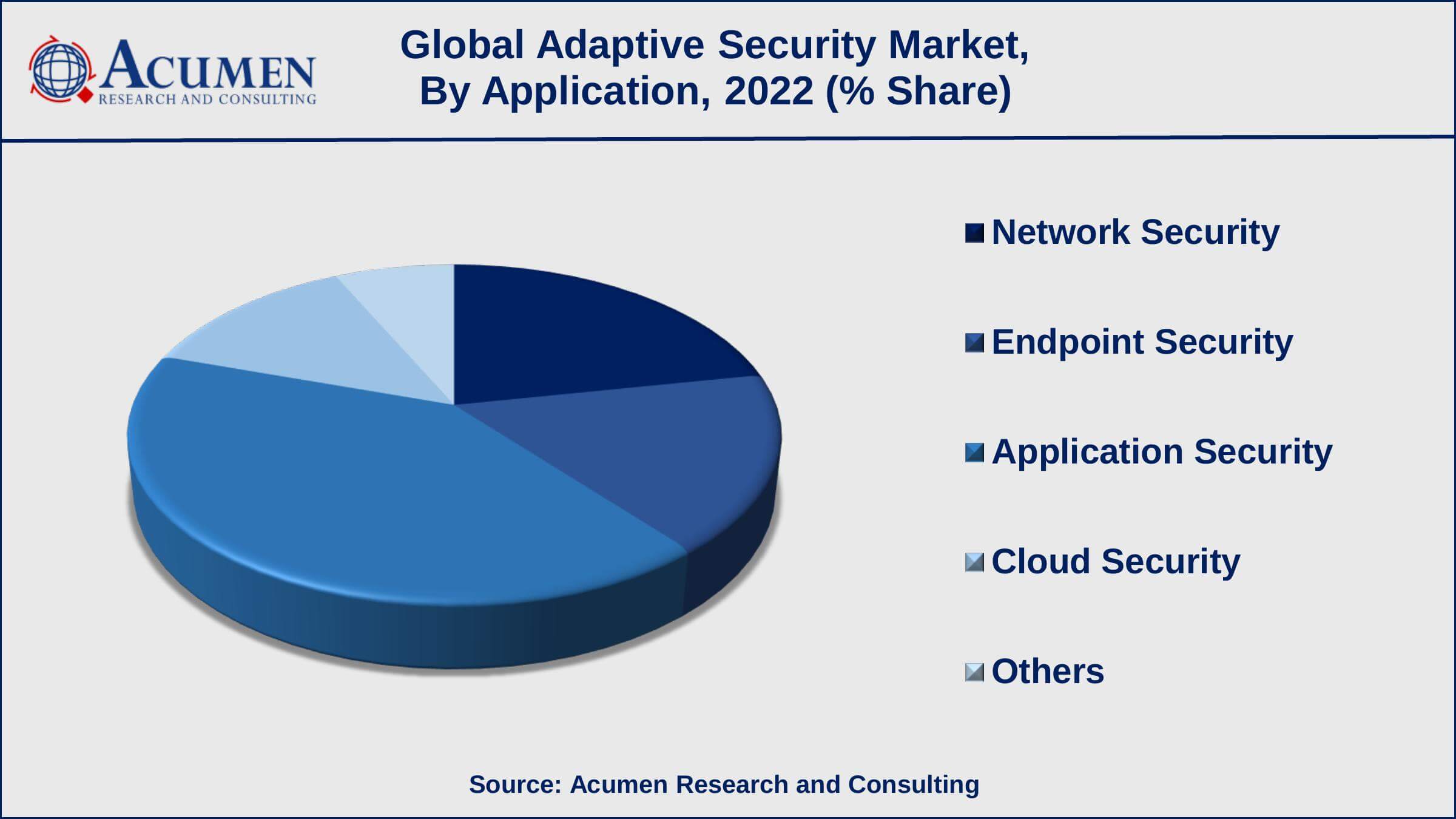Adaptive Security Market | Acumen Research and Consulting
Adaptive Security Market Size - Global Industry, Share, Analysis, Trends and Forecast 2023 - 2032
Published :
Report ID:
Pages :
Format : 
The Global Adaptive Security Market Size collected USD 6,489.2 Million in 2022 and is set to achieve a market size of USD 23,685.6 Million in 2032 growing at a CAGR of 13.9% from 2023 to 2032.
In the modern-day world where there is an enormous amount of data generation, it is extremely important to protect classified data from external threats. Antivirus programs and firewalls, in most cases, are proving incapable of protecting classified data, which creates a need for better security measures. Adaptive security is an approach to safeguard the data and system by identifying threat-related behavior instead of files and codes that are used by virus definitions.
Organizations have adopted firewalls to maintain pace with threats and protect applications, enterprise data, and networks and are continuously upgrading them. However, technologies are inter-connected and this integration such as IoT-based systems and cloud affects the complexity of computing devices and thus becomes more dynamic and distributed. Hence, security focus is diverted from the exterior to the interior system. This diversion of security results in a security breach in global organizations such as banks, and personnel management offices. This has further led to the adoption of adaptive security systems by all types of small and large organizations to avoid attacks from outside or within the organizations.

Adaptive Security Market Report Statistics
- Global adaptive security market revenue is estimated to reach USD 23,685.6 million by 2032 with a CAGR of 13.9% from 2023 to 2032
- North America adaptive security market value occupied more than USD 2,076.5 million in 2022
- Asia-Pacific adaptive security market growth will register a CAGR of more than 8.5% from 2023 to 2032
- Among component, the services sub-segment generated around 58% share in 2022
- By application, the application security accounted for US$ 2,660.6 million in 2022
- The adoption of cloud and IoT technology is a popular adaptive security market trend that fuels the industry demand

Global Adaptive Security Market Dynamics
Market Drivers
- Increasing complexity of cyber threats
- Growing need for security compliances and regulations
- Adoption of cloud and IoT technology
Market Restraints
- High implementation cost
- Lack of skilled personnel
- Privacy concerns
Market Opportunities
- Increase in investment in cybersecurity
- Surging adoption of cloud-based security technologies across organizations
Adaptive Security Market Report Coverage
| Market | Adaptive Security Market |
| Adaptive Security Market Size 2022 | USD 6,489.2 Million |
| Adaptive Security Market Forecast 2032 | USD 23,685.6 Million |
| Adaptive Security Market CAGR During 2023 - 2032 | 13.9% |
| Adaptive Security Market Analysis Period | 2020 - 2032 |
| Adaptive Security Market Base Year | 2022 |
| Adaptive Security Market Forecast Data | 2023 - 2032 |
| Segments Covered | By Component, By Application, By Organization Size, and By Industry Vertical, And By Geography |
| Regional Scope | North America, Europe, Asia Pacific, Latin America, and Middle East & Africa |
| Key Companies Profiled | Trend Micro Incorporated, Cisco Systems, Inc., Rapid7 LLC, Juniper Networks, Inc., Fortinet, Inc., RSA Security LLC, Hewlett Packard Enterprise Company, Panda Security, CloudWork. |
| Report Coverage |
Market Trends, Drivers, Restraints, Competitive Analysis, Player Profiling, Covid-19 Analysis, Regulation Analysis |
Adaptive Security Market Growth Factors
Adaptive security changes and evolves with the computing environment to inspect the computing environment uninterruptedly. The adaptive security mechanism is an integration of software and hardware which provide security to the core of computing infrastructure and protects it against the cloud-based ecosystem and remote devices. When the workload in any application process grows, adaptive security adapts to it and keeps track of the changes. It re-computes the security parameters as the environment changes across all public clouds, data centers, and hybrid environments. It enables organizations in writing security policies without any interaction with the network. During the instance of malware or cyber-attack, adaptive security helps in isolating the concerned part from the infrastructure, and thus reduces the risk of attack area on the entire system. Adaptive security is a network security model required to accommodate the emergencies of various perimeters and moving files and packets on a network and exerts advanced threats which target such enterprises. Adaptive security keeps an eye on the network for identifying real-time changes, behavioral anomalies, malicious traffic, and end-point vulnerabilities, automatically enforces access rules and endpoint protections follows a compliance dashboard, and provides audit data among others.
The key factors driving the global adaptive security market include the increasing risk of high-end attacks, varying technologies in infrastructures, and damages to crucial infrastructure due to rising online threats. However, the low time efficiency provided by adaptive security systems is a key factor limiting the growth of the global adaptive security market.
Adaptive Security Systems Market Segmentation
The worldwide adaptive security market is categorized based on components, applications, organization size, industry verticals and geography.
Adaptive Security Market By Component
- Solution
- Services
- Managed Services
- Professional Services
- Training and Education
- Support and Maintenance
- Consulting

Services will have a significant market share in 2022, according to an adaptive security industry analysis. Adaptive security is a rapidly expanding market, and it is unsurprising that services play a significant role in it. Adaptive security services are intended to assist organizations in improving their security posture and responding in real-time to evolving threats. Security consulting, threat intelligence, managed security services, and incident response are examples of such services. Companies that provide these services can provide their customers with the expertise and resources they require to protect their networks and data from cyber threats.
Adaptive Security Market By Applications
- Application Security
- Cloud Security
- Endpoint Security
- Network Security
- Others (Database Security and Web Security)

According to the market forecast for adaptive security, application security will have the largest market share from 2023 to 2032. Because many organizations rely on software applications to manage their business operations and store sensitive data, application security is a critical component of the overall cybersecurity landscape. As a result, it's not surprising that application security has dominated the adaptive security market. Adaptive application security solutions are intended to protect software applications in real time by automatically detecting and mitigating potential threats. Application firewalls, runtime application self-protection (RASP), and software composition analysis are examples of such technologies.
Adaptive Security Market By Organization Size
- Large Enterprises
- Small And Medium-Sized Enterprises (SMEs)
Large enterprises have captured the majority of the market share in the adaptive security market. Large enterprises typically have more resources and a more extensive IT infrastructure, making them more vulnerable to cyber threats. They also have a greater need for advanced security solutions to safeguard sensitive data and their reputation. The increasing complexity of cyber threats, as well as the need to comply with regulations and standards such as the General Data Protection Regulation (GDPR) and the Payment Card Industry Data Security Standard has fueled demand for adaptive security solutions among large enterprises (PCI DSS).
Adaptive Security Market By Industry Vertical
- BFSI
- Retail
- Manufacturing
- Education
- IT & Telecom
- Healthcare And Life Sciences
- Energy And Utilities
- Government And Defense
- Others
The IT and telecom industries are the most rapidly growing in the adaptive security market. The IT & telecom industry is one of the most technologically advanced, relying heavily on software applications, networks, and infrastructure to function. As a result, the IT and telecom industries are prime targets for cyber threats, necessitating the need for advanced security solutions. The rapid growth of the IT and telecommunications industries in the adaptive security market is most likely a reflection of the growing demand for these solutions in this industry, as organizations seek to protect their assets and ensure the security of their networks and data from cyber threats.
Adaptive Security Market Regional Outlook
North America
- U.S.
- Canada
Europe
- U.K.
- Germany
- France
- Spain
- Rest of Europe
Asia-Pacific
- India
- Japan
- China
- Australia
- South Korea
- Rest of Asia-Pacific
Latin America
- Brazil
- Mexico
- Rest of Latin America
The Middle East & Africa
- South Africa
- GCC Countries
- Rest of the Middle East & Africa (ME&A)
Adaptive Security Market Regional Analysis
North America is expected to account for a sizable portion of the global adaptive security market. This is due to the presence of major players in the region as well as the early implementation of advanced security solutions. The region is home to some of the world's largest corporations and governments, which are heavily investing in cybersecurity to safeguard their assets and data. This is fueling demand in North America for adaptive security solutions.
In the coming years, the Asia-Pacific region is expected to see significant growth in the adaptive security market. This can be attributed to the region's increasing technological adoption and the growing number of SMEs. Some of the region's fastest-growing economies, such as China and India, are seeing a rapid increase in the number of SMEs. These SMEs are embracing technology to improve their operations and competitiveness. This is fueling demand in the Asia-Pacific region for adaptive security solutions.
Adaptive Security Market Players
Some of the leading adaptive security companies include Cisco Systems, Inc., CloudWork, Fortinet, Inc., Hewlett Packard Enterprise Company, Juniper Networks, Inc., Panda Security, Rapid7 LLC, RSA Security LLC, and Trend Micro Incorporated.
Frequently Asked Questions
What was the market size of the global adaptive security in 2022?
The market size of adaptive security was USD 6,489.2 Million in 2022.
What is the CAGR of the global adaptive security market during forecast period of 2023 to 2032?
The CAGR of adaptive security market is 13.9% during the analysis period of 2023 to 2032.
Which are the key players operating in the market?
The key players operating in the global market are Cisco Systems, Inc., CloudWork, Fortinet, Inc., Hewlett Packard Enterprise Company, Juniper Networks, Inc., Panda Security, Rapid7 LLC, RSA Security LLC, and Trend Micro Incorporated.
Which region held the dominating position in the global adaptive security market?
North America held the dominating position in adaptive security market during the analysis period of 2023 to 2032.
Which region registered the fastest growing CAGR for the forecast period of 2023 to 2032?
Asia-Pacific region exhibited fastest growing CAGR for adaptive security market during the analysis period of 2023 to 2032.
What are the current trends and dynamics in the global adaptive security market?
The current trends and dynamics in the adaptive security industry include increasing complexity of cyber threats, growing need for security compliances and regulations, and adoption of cloud and IoT technology.
Which component held the maximum share in 2022?
The solutions component held the maximum share of the adaptive security market.
Select Licence Type
Connect with our sales team
Why Acumen Research And Consulting
100%
Customer Satisfaction
24x7
Availability - we are always there when you need us
200+
Fortune 50 Companies trust Acumen Research and Consulting
80%
of our reports are exclusive and first in the industry
100%
more data and analysis
1000+
reports published till date



